Archive for the ‘Emerging Media’ Category
VR: It May Be Difficult to Monetize Isolation
In 1909, E.M. Forster wrote a short story titled “The Machine Stops” that is set in a post-apocalyptic Earth in which humanity exists underground in a network of tubes. Each individual lives alone in a small hexagonal room and social interaction is through a screen. The majority of the population worships the Machine that they live in and fear the outside world. Over a 100 years later, E.M. Forster’s short story appeared incredibly prescient during the height of the pandemic, however, even before the pandemic, as people stare at their screens, the short story has reflected elements of current day life. Throughout the very short history of advertisement, our eyes and attention have been the commodity. Today as virtual reality (VR) and augmented reality (AR) attempt to gain a foothold as major media platforms, our eyes focus upon small screens. The films we once watched on giant movie screens with state of the art sound systems are now consumed during a commute on a handheld screen and headphones. The smart phone and every related technology has been transformative from production to consumption. However, when we click on a mobile digital ad, it remains largely accidental. A quick “damn it” and click on an X closes the ad and returns us to our happy stream. In order for VR and AR platforms to gain a foothold in society, they must be financially viable which means that the ad streams must be commercially relevant and not a mistaken pupil glance or blink. Have we been prepared to live in the machine or do we already exist in the machine and merely need to incorporate the screens as a headset? It may very well be that many people would opt to wear their smartphones rather than have to hold them.
Meta, the corporation once known as Facebook that owns WhatsApp, Oculus, Instagram and is the greatest promoter of the so called metaverse, lost half a trillion dollars on October 27th 2022. Mark Zuckerberg, CEO of Meta, has declared that the metaverse is a long term endeavor and that IT IS the future. In 2021, Apple handed over to the user whether or not one’s data is tracked for advertising and with the loss of the iOS tracking data, the value of targeted advertising has plummeted. Over the last few quarters, Alphabet (the parent company of Google) has had a 5% decrease in advertising pricing, however, Meta’s decrease has been an 18% price loss per advertisement. The loss of ad revenue is reflected in a drop of Alphabet and Meta’s stock value, however, again the Meta stock value has plummeted in comparison to Alphabet. This may be a short term falter or it may reflect that these companies do not have a lasting value.
Over the last six years I have been critical of virtual reality, however as a “new media artist” I have been curious and open to new creative platforms and I have been developing projects that are exported for both the desktop and virtual reality. Today, I remain highly skeptical of placing a device a couple inches from one’s eyes with a split screen for stereoscopic imaging to create an “immersive experience.” I feel that it is unhealthy and ridiculous. During the week of October 20th, I participated in DIGITAL ART ZURICH, a festival featuring several virtual reality (VR) projects. I witnessed one person come away from an interesting VR project feeling sick, unable to focus and state that if that is the future, they want no part of it. Later that day, this same person told me that it was at least two hours before they felt clear minded and well. I experienced the same VR project that was seated and had me dollying through a sci-fi narrative. In this project, teleporting and physically moving about was not available. I was fine through the experience, however, by the end I was sweating, the headset had become hot, heavy and uncomfortable and I badly wanted it off my head. The project lasted 10 to 15 minutes.
In a different gallery, there was a standing VR project that did not dolly the user through virtual environments and the only movement was to look around. This project was less uncomfortable. The greater issue here is that each user is isolated in their headset and the project itself seemed disorganized or without a central and coherent point. In the same gallery, there were desktop projects presented on large screens with keyboard and mouse interaction. With these projects, I saw friends sitting together, playing and discussing the projects.
A few weeks ago, I brought home an Oculus Quest 2, produced by Meta. My 14 year old son begged that I purchase an NFL VR game. I did so and then for 20 minutes, he was isolated in the headset throwing touchdowns. Previously, we would watch or play games together. Meta CEO Zuckerberg states that the metaverse will be social. Meta has launched Meta Quest Pro, a virtual and mixed reality headset. I have tried Microsoft’s mixed reality HoloLens and view it as a far superior experience to virtual reality, because I can see and interact with the real world environment while also seeing a virtual overlay. I do believe that mixed reality has a future if our eyes and minds can adapt to it. I do not feel the same about virtual reality.
I am an associate professor in the Department of Film & Media Studies at Hunter College. I teach an introductory digital production course that is split between a lecture and laboratories. The lectures present histories and theories regarding visual communication, graphic design, photography, animation, game production and non-linear storytelling. During the pandemic, the lectures and labs went online. This school year, the labs have returned to in-person, however the evening lecture has remained online. Attendance to the lecture has plummeted, perhaps it is my presentation or the fact that I record the lectures and provide my slides and notes, but I think the underlying issue is that it’s online. I regularly receive emails about free online lectures and if the topic is of interest, I sign up. However, of every ten lectures that I sign up for, I may attend one and many times I do not stay through to the end. Online lectures, virtual reality, distance learning, do not carry the commitment and strength of in-person interaction and experience. It’s difficult to blame the student.
Meta may be able to suffer ongoing financial losses. And Meta may find a way to resuscitate Facebook or monetize WhatsApp or Instagram or turn Oculus into an advertising platform; the bottom line is that technologies for mass adoption require immense funding. Over the last six decades, VR experiments have been promoted as the future of entertainment or gaming only to fail. I firmly believe that a mass audience does not want to wear a headset to be isolated with a screen a couple inches from their eyes. In my experience, even the social VR platforms through avatar interaction are isolating and dystopian. Perhaps the mixed-reality Meta Quest Pro will be a success and this is the moment to invest in Meta as the stock has fallen to a 2015 price. As mixed-reality headsets use eye tracking for navigation, it may very well be hard for users to not accidentally click on virtual ads an inch from their pupil and Meta’s price per ad will skyrocket.
Chasing Bits a Web Platformer Game

“No Media” is an online exhibition featuring art work entirely made from code. This means no media files – no jpg or gif or png or mp3 or wav or mp4 or webm or any type of self-contained file type. When I was invited to participate in this exhibition, it was a tricky proposition for me as I’m primarily a visual artist who uses software and generally when I code it’s in an environment such as Visual Studio with Unity. My web projects tend to include SVGs created in Illustrator or video or audio files… But I greatly appreciated the invitation and the challenge to work differently. However, I’m not a good coder, generally, I hack things together or review endless tutorials. In grad school at Carnegie Mellon University, I was allowed to enroll in the Computer Science intro to programming undergraduate course. This is a course designed to weed out those who will not go on to become programmers; I lasted three weeks.
I regularly use javascript, the language of the web, I wanted to make something that would be fun for people to interact with and I had been researching digital currencies for the last couple of years for another project. Since I was 11 years old, I’ve loved platformers due to my initiation as Activision’s Pitfall Harry in 1982. So I decided to take Marijn Haverbeke‘s entirely code-based javascript platformer game covered in his book Eloquent Javascript and inject it with a bit of Bitcoin and alt coin content. I feel that the platformer presents the ideal game metaphor for the dreams and pitfalls of alt coins. The game titled Chasing Bits has audio, but it’s the browser’s speech synthesis that reads a hidden text (no media). And there are emojis that may appear to be image files, but are also bits of code. (It’s probably time to add the death emoji.). There is one live data feed – the current value of Bitcoin which you may update throughout the game.
Since web audio generally requires a user event, players must click a button to trigger the browsers reading of the following passage:
What happens when a utopian idea for a decentralized currency gains adoption in the midst of hypercapitalism? Speculative investors looking to get rich quick, loose. The early bird gets the worm, the rest just dig for fools gold. Or perhaps the current value of bitcoin will triple and you head straight to the Cayman Islands to sip on rum and coke as you lazily sway in a hammock between shade and sunlight.
Unfortunately it is 2022, the U.S. government slowed the printing of free money, inflation has risen, uncertainty has set in and the happy go lucky period of Bitcoin and alt coins has taken a pause. Sit tight, wait 10 years and just maybe those Ethereum coins will be worth eighty thousand each! Or perhaps, the Financial Action Task Force may just clamp down and regulate Bitcoin and digital currencies due to money laundering and other criminal use of digital currencies. No one knows what lays ahead. So meanwhile, why not chase those bits…
I can not afford real property, so I buy land in the metaverse. I like going there in the evenings when I sit alone and wonder when others will join. Perhaps I will rent out some space and make more bits. However, I don’t like it when the earth quakes.
As soon as Bitcoin peaks again, I will buy a pig to store clones of all my primary organs, this way I will double my life span and live to a 180 and by then I will own a country in the meta verse and deliver my own currency. My anti gravity suit will keep me looking young. Meanwhile I will continue chasing bits.
Try the Chasing Bits, listen to that audio, check the current value of Bitcoin, I hope you are mildly entertained!
Review of “The Linguistic Errantry”
Imagine an immersive Boschian landscape rich with metaphoric allusions of surveillance and control, such is artist Tansy Xiao’s latest creation. The desktop application “The Linguistic Errantry” puts the user/player in a surreal yellow hued environment populated by singing giraffes, floating goldfish, levitating eggs, flying surveillance cameras and a giant broken egg with octopus tentacles dancing about. In a desert-like setting, enclosed by rock cliffs, Marxist monuments stand erect but their heads are 19th century copper and brass diving helmets. A buddha on lotus monument is surrounded by surveillance monitors that show the world itself as captured by the roving surveillance cameras. This world reflects upon “the totalitarian lockdown in Shanghai.”
“The Linguistic Errantry” is a first person roaming world. Walk past any of the 14 giraffes and you will hear it singing brief notes.
Each giraffe is set to sing a measure constituting 2-4 notes and nonlinguistic lyrics deconstructed from L’Internationale. When two giraffes collide, they adopt each other’s measure to add to their own array. Giraffe 0 as the only exception, is set to speak “Control / Your / Soul’s / Desire / For / Freedom” by default, instead of singing—a propaganda phrase from a government official during the totalitarian lockdown in Shanghai, when the whole country entered an Agambenian “state of exception.” Each word occupies one slot in its array and will be gradually replaced by fragments from L’Internationale as giraffe 0 encounters the others of its kind.
https://www.tansyxiao.com/the-linguistic-errantry
As game engines have become more accessible and adopted by artists to create immersive worlds layered with meaning and cultural critique, it is exciting to see Xiao adopt the game platform to create a powerful metaphoric world that easily stirs investigation and reflection in the viewer. As Xiao further describes “The Linguistic Errantry reimagines the Tower of Babel in a way that manifests the arbitrary nature of history: the consolidation and disintegration of sovereigns, an anticipated revolution to be generated by mere chance, or a parallel universe where nothing ever happens and only entropy reigns supreme.”
NFS NSFW NFT Exhibition Is Live!
NFS NSFW NFT is a 3D virtual exhibition produced by members of NEW INC and Rhizome’s Art & Code track. The exhibition is on New Art City, hosting a Zoom opening, minting a NFT on Foundation, and closing with a panel at Hunter College — all, to explore the critical poetics of this particular not-for-sale, not-safe-for-work, and non-fungible-token moment. The exhibition is composed of three galleries:
The NFS garden is skinned with cryptocurrency symbols and animations. Featuring work from Ricardo Miranda Zúñiga, Mark Ramos, and Bhavik Singh.
The NSFW garden is skinned with community rules and blurred graphics that platforms use to police adult content. Featuring work from Itziar Barrio, Christopher Clary, Nahee Kim, and Pearlyn Lii.
The NFT garden is skinned with graphics that corporations use to illustrate the blockchain. Featuring work from Johanna Flato, Lula Mebrahtu, Yeseul Song, and Ziyang Wu.
I contributed two works – a mock real estate advertisement and a sphere skinned with crypto logos that houses an audio file.
I created the real estate video advertisement featuring actress Sajda Waite for a desktop and virtual reality app titled Desplazados. Desplazados is a wandering world application set in a 19th century tenement neighborhood. One explores the environment populated by disembodied voices that share observations and personal stories regarding urban gentrification and dislocation. The voices are street interviews that I conducted as the 1 billion dollar development Essex Crossing broke ground. As one spends time with Desplazados, old buildings explode and new glass towers rise. By the end of the 20 minute experience, one is surrounded by glass skyscrapers. The video advertisement is one of two scripted elements in the app.
The crypto sphere presents logos of some of the more prominent crypto or alt currencies. When one enters the sphere, you hear a snippet of a conversation with artist Grayson Earle who created Bail Bloc, a blockchain app that when running on one’s computer generates funds for the Immigrant Bail Fund of New Haven CT that aids immigrants detained by ICE. The interview is part of a project I’ve been working on over the past year titled FinTech for the Precariat that investigates the effects of emerging financial technologies. As with Desplazados the project is a desktop and VR app that will feature 12 interviews with artists, financial specialists and individuals who have been living in financial distress.
Both these projects question speculative commerce and investing and the disparity and distress that the financialization of human existence causes.
Lindsay Howard wrote an inspiring essay regarding web3 and the possibilities of decentralized currencies and collective action. Written in a manifesto style that condemns the exploitative nature of web2.0 social network corporations, the essay is titled “Innovative Economies.”
The Golden Age of FinTech

FinTech for the Precariat (working title) is a net art work that speculates on the false promises of income distribution in the Age of Bezos. COVID-19 has compounded existential insecurity; the pandemic of stress has been inseminated by the novel flu virus to birth a new reality – a chasm of uncertainty. As unemployment soars, speculative futures drive a stock market that has largely rebounded from the initial shock, but on what basis? The basis that this moment will soon pass and the age of plutocrats, technocrats and authoritarianism will continue thriving a year from now; the slight disruption soon forgotten. The agenda of economic growth must be embraced at the cost of human health. After all, those who enjoy the economic growth will remain safely at home in their condo or rural cabin or yacht.
It has been projected that the 2020s will be the decade of the FinTech Revolution. This marketing hyperbole is on the heels of many such revolutions – the Green Revolution, the Personal Computing Revolution, the dot.com, web2.0 and Social Network Revolution… These revolutions are sold on the promises of democratization and wealth. And they always leave a toll from cancer and the privatization of agriculture to unparalleled surveillance. Today financial technologies present the promise of democratizing complicated transactions, facilitating personal banking, mass speculation in stocks… Whether budgeting or gambling, these tools are relatively harmless. However, entirely new finance mechanisms or rather schemes are being developed as part of FinTech including autonomous finance, bitcoin and ultimately the financialization of human existence. A sector of FinTech will compound income inequality nationally and globally to insurmountable levels. As made abundantly clear by world leaders, finance no longer serves humanity, humanity serves finance.
Question of Intelligence
Before COVID-19 shutdown New York City, I had the opportunity to experience the exhibition “The Question of Intelligence – AI and the Future of Humanity” curated by Christiane Paul at Parson’s Kellen Gallery. I did not enter the exhibition expecting to witness disparate algorithms animating the exhibition space. It took me a few minutes to realize that the empty gallery (populated only by myself and two silent gallery sitters busily working, I suppose, on their school work) was brought to life by artworks forced to listen to one another and respond. I’m talking about artworks sensing via microphones, cameras, the internet; processing through artificial intelligence, machine learning, algorithms; and communicating via speakers, projectors, screens, printers, the internet and miniature swamps.
Christiane Paul has assembled elder artificial intelligence artworks over 40 years old (though still learning) with nascent works just starting to realize themselves. With the popular explosion of catch phrases including “Big Data,” “AI,” “Machine Learning,” “Today, right now, you have more power at your finger tips than entire generations that came before you…” (I used to appreciate Common before the Microsoft commercial, now I cringe when I hear his voice), Paul has curated a learning experience that recognizes the generational history of artificial intelligence as a creative medium.
Upon entering the gallery, one hears female artificial voices generating poetry or relating temperatures and soil humidity and other environmental measures or in the distance an occasional tweet. To the left, I saw a big black microphone and elected to approach it as the first means toward interactivity. I introduced myself and then watched my words projected onto the wall along with Chinese-style landscape paintings. Trails are drawn from word groupings to word groupings along with drawn landscapes and icons forming a word and image map. The projection is a mind map generator based on the words captured by the microphone. Following a few phrases, I decided it wasn’t very interesting and decided to move on. Adjacent to it is Lynn Hershman Leeson’s chatbot Agent Ruby (2001), but having interacted with one of Leeson’s works at Yerba Buena’s “The Body Electric” recently, I only spent a minute with it before moving on, also it didn’t know what to make of what I was telling it.

Adjacent to the chatbot, is Lior Zalmanson’s “image may contain” in which the artist feeds historically significant images into FaceBook’s Automatic Alternative Text image recognition algorithm, an accessibility AI to help contextualize images for the blind and sight impaired. The artists uses the uncontextualized and minimal description of the historical images to identify “similar” images and then collapses them onto lenticular prints. Above are the images that appear in the first print as I move from left to right. The work simply and clearly shows that bots such as AAT should not be used to present information and least of all pretend to be a source of knowledge, at least not yet.
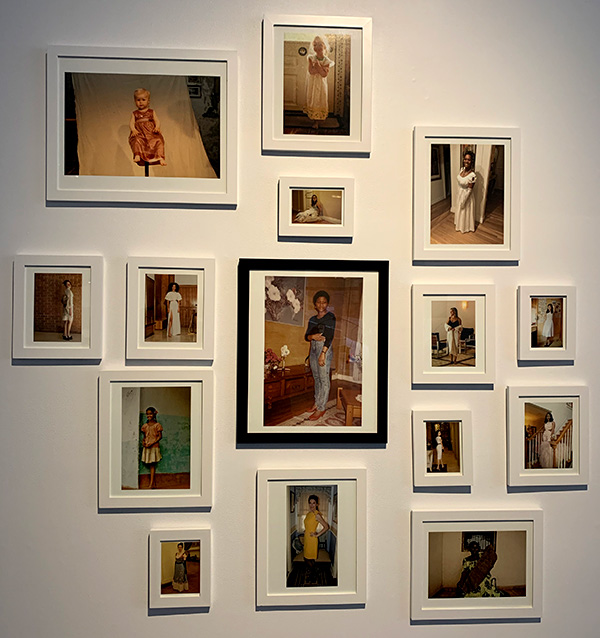
Similarly, Mimi Onuoha uploaded a photo of her mother “to Google’s reverse image search, which allows one to upload a picture to find online images that the Google algorithms identify as related.” Scaled, printed and framed from the initial image at the center to the algorithmically related images encircling, a seemingly family home portrait wall appears, leading one to question the process of algorithmic categorization based entirely on visual similarity. With such a project, I can’t help but recall eugenics and Sekula’s “The Body and the Archive.”
I then circled back toward the center of the gallery to try and figure out what was going on with “The Giver of Names” by David Rokeby. And it wasn’t until I read the instructions and changed the objects on the pedestal to assemble my own still life that the brilliance of the exhibition really dawned on me!
“The Giver of Names” (naming since 1990) consists of a monitor, speaker, old CCTV camera, pedestal, pile of old toys and a program that tries to understand what it is seeing through the camera to generate poetry. Once I removed the toys left on the pedestal and placed my own selection, I watched the AI go into action by identifying shapes and colors and then trying to make sense of what it was identifying or “seeing.” Those shapes and colors feed a poetry algorithm that speaks and writes to the monitor adjacent to the CCTV camera. Meanwhile, just beyond this installation, the not very interesting mind mapping microphone is also capturing this generated poetry as it echoes across the gallery and starts mind mapping away. AWESOME! The gallery is its own loop of machines churning away at one another’s utterances. This realization helped me refocus my attention and expand my time with each work. I tried to capture this in the video at the top of this entry.
Near the entrance on a wall monitor, hangs AARON which I had merely paused at for a few seconds but now returned to observe. “AARON is the earliest artificial intelligence program for artmaking and one of the longest running ongoing projects in contemporary art. Harold Cohen started creating AARON at UCSD in the late 1960s and developed the software until his death in 2016. In this video AARON produces a new color image every 10 to 15 minutes.” As one tours the gallery, AARON is quietly working away creating shapes and lines of color, artful abstractions.
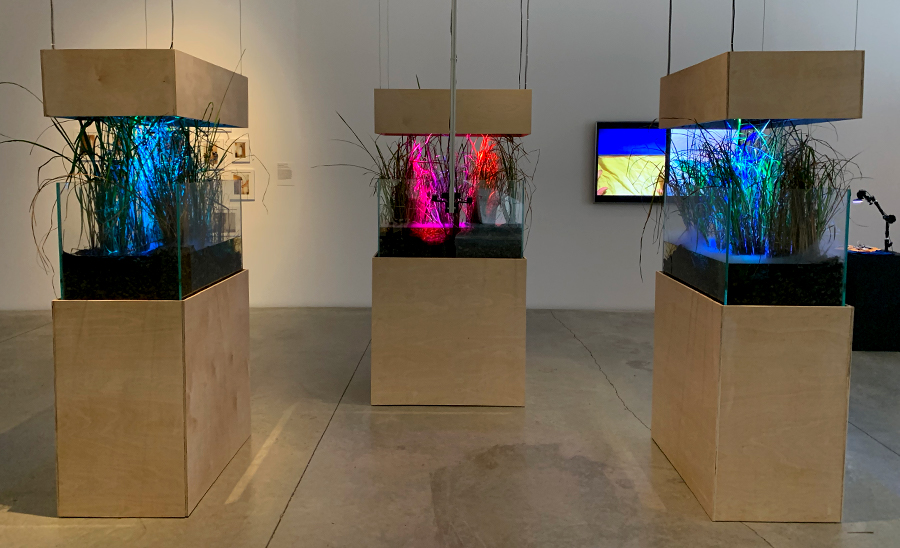
Back near the center of the gallery, just beyond “The Giver of Names” is another work with a female computer voice speaking at intervals. Tega Brain’s “Deep Swamp” asks “if new ‘wilderness’ is the absence of explicit human intervention, what would it mean to have autonomous computational systems sustain wild places?” The handsome installation has three AIs, Nicholas, Hans and Harrison each “engineer their environment for different goals. Harrison aims for a natural looking wetland, Hans is trying to produce a work of art and Nicholas simply wants attention.”
“Learning to See” by Memo Akten uses machine learning to relate the objects on a pedestal that a camera captures to five different data sets that the system has been fed. The visitor can re-arrange the objects on the pedestal to see new interpretations. Across from the pedestal on a wall is a split screen that shows the image captured by the camera adjacent to the system’s interpretation. “Every 30 seconds the scene changes between different networks trained on five different datasets: ocean and waves, clouds and sky, fire and flowers, and images from the Hubble Space telescope.
Similarly across the gallery, hang a series of prints by Mary Flanagan. The work is [Grace:AI] in which generative algorithms trained on thousands of paintings and drawings by women to create a series of images. “[Grace:AI] was tasked to create her ‘origin story’ by looking at 20,000 online images of Frankenstein’s monster and producing its portrait.”
Both “Learning to See” and “[Grace:AI]” employ generative adversarial networks (GAN), to generate new visualizations. Using GAN anyone can put their own conceptual spin to generate a data set for the machine to learn and see what it spits out. Over the last few years, I’ve seen a few similar projects, my favorite remains an early one – the MEOW Generator trained on a cat dataset.
Perhaps the most darkly monumental project are the large four black machines with spinning fans, exuding steam and ticker tape – the installation component of #BitSoil Tax by LarbitsSisters. The project proposes the fair redistribution of internet wealth to all people through a new taxation system. The installation is utopian, dark and whimsical.
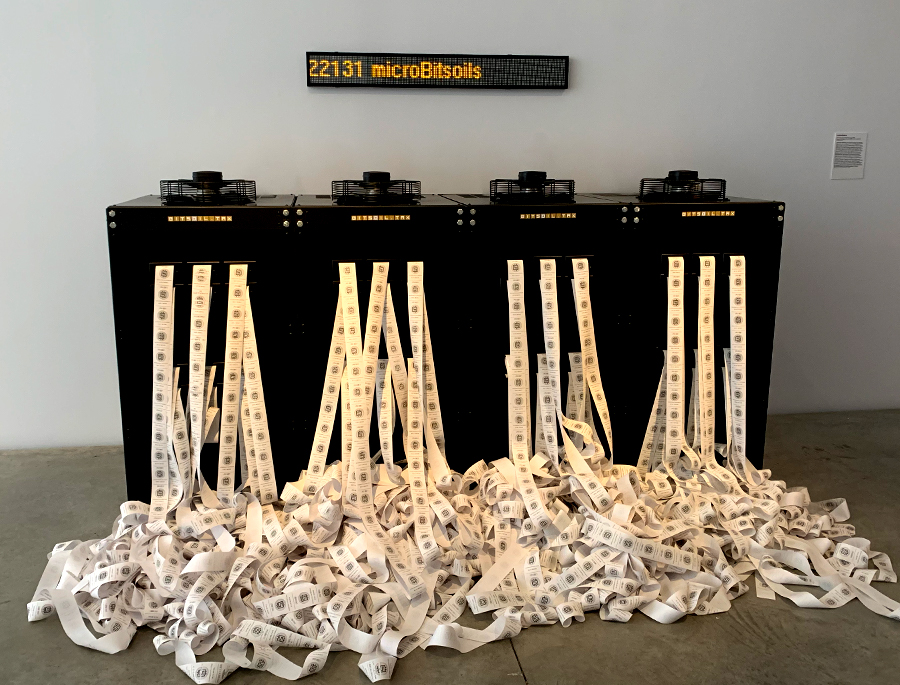
Other projects on exhibit include “Futures of Work” by Brett Wallace, and Ken Goldberg and the AlphaGarden Collective.
Realidad VE
Realidad VE is a small experiment that attempts to combine documentary material with virtual space for VR presentation.
Last fall I had an extended interview with José Bergher a retired professor and classically trained musician from Venezuela who was the director of the Symphony Orchestra of Venezuela. Throughout his professional career he worked between New York City and Caracas and the reason behind the interview was to learn about that dual citizenry – about living between cultures and floating from one part of the world to the other. However as the interview progressed, I asked José about the current state of Venezuela – politically, economically and the common problems that people face day to day. He replied with a 20 minute discussion of the rise of Chavez and the current power-grab by Maduro and the lasting influence of Fidel Castro.
I knew that this discussion would not be appropriate for the project that I was working on, but I appreciate his first-hand perspective and given the last several weeks in Venezuela, I wanted to present his voice in a unique format. Entirely based on my news consumption of current protests, clashes and seemingly general instability in Venezuela, I created a blank world with the exception of dead trees and abandoned drilling rigs. The world is populated by men and women running across the space. A boy sits against a tree taking in the world around him. At another spot a young couple argues and elsewhere two friends are in discussion. Along the entire perimeter paramilitary troops stand guard and watch the space. At a couple spots trios of soldiers have friendly discussions. In this world, the military is at ease, though watchful whereas the people appear frantic.
I’m interested in combining documentary material such as the interview with José Bergher with virtual space and employing virtual reality as a platform for documentary. Jose’s discussion of current Venezuelan politics presented an opportunity for experimentation. Pictured above is the project for installation that features an animated José Bergher above the virtual space, the project is online with out Bergher’s video, only his voice accompanies the virtual space as the inclusion of video made an already long load time much longer.
“Hansel & Gretel” at Park Avenue Armory – Save Your Money

The “Hansel & Gretel” curatorial statement describes the installation as a space that brings together Jacques Herzog, Pierre de Meuron and Ai Weiwei combined interests in
the psychological impact of architecture and the politics of public space; creating a playful, strange, and eventually eerie environment with different layers of reality revealed to the visitor… Hansel & Gretel is a dystopian forest of projected light where the floor rises up, as if lifted by an invisible force, and visitors are tracked by infrared cameras and surveyed by overhead drones as they systematically capture the parkgoers’ data and movements…
Unfortunately, the only portion of this description that resonates is the playfulness. Indeed Herzog, de Meuron and Weiwei have created a dark environment in which visitors may skip around and play with light traces of their image. However, the installation lacks strangeness, eeriness, politics or any psychological reverberation.
Other than the initial moment of discovery that one’s image is being projected on to the ground after it is periodically taken due to on one’s movement in the space, the installation presents very little that is interesting. The drones may have been a neat prop had they not been tethered.
The second part of the installation is a didactic revelation of what the installation is trying to allude to – that we are objects of surveillance. As far as a critical art installation regarding surveillance, there was much more interesting work done 15+ years ago. Perhaps the theme of surveillance has been so overly investigated and picked apart by art previously and by entertainment today (“Black Mirror” for example) that such an installation seems trite and naive. There is so much of our data being captured today, that building an installation that merely plays upon facial recognition and motion sensors is just kind of dumb, but it is playful. So if $16 is worth the cost of running around a huge dark open space and playing with light projection, check it out.
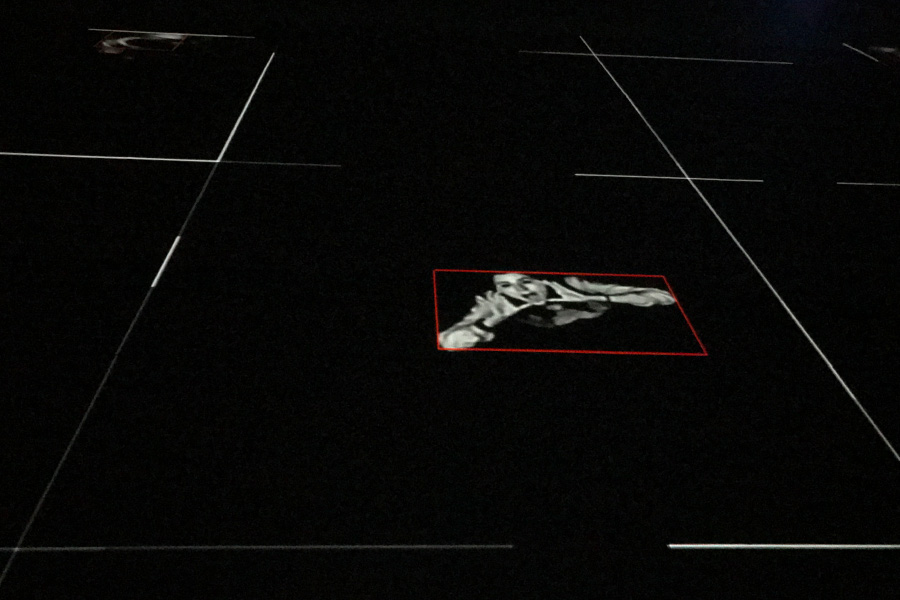
A second perspective: Playtime at the Armory
Once again discovering what this city has to offer, there I was with Ricardo walking into a venue called the Armory near Hunter College, a place I had never been before to see a new art installation called “Hansel & Gretel”. He had been keen to check this out for a few weeks, and like the curious creature I am, I followed along.
We received a quick intro and were instructed to read a phase on the wall before entering -which i forgot- and then allowed to enter. We walked into black nothingness. My immediate reaction was to scramble for Ricardo’s hand. I didn’t realize the massiveness of this place until my eyes adjusted from the summer sunlight to the darkness inside of the Armory. It was only eerie the first few minutes because I had no idea where the hell I was walking. There were a few cameras far above us hanging from the ceiling and lights that would follow us. As we continued to walk, our movement was detected, grid lines would appear and cameras would be activated to capture our moves. Suddenly, it was playtime! It was fun to pose in different positions to watch the resulting snap shot of yourself illuminated on the black floor. At one point my sweater and shoes came off and I really got into it.
Ricardo noticed two drones hovering on one side of the space living poor unfulfilled lives- tied onto leashes without free movement. It would have been more interesting if they were chasing people around. After exhausting our ideas for poses, the novelty wore off and we were ready to enter part deux of the installation. For that, we had to exit this part of the Armory and enter from another entrance on the other side of the street.
After pausing in front of a camera you were allowed inside. There were many ipads on long tables with apps. You could elect to have your face identified and then search the cameras for your photo which was taken in the first part of the installation. That was cool. You could read about the history of surveillance, or access cameras to spy on others walking into the exhibits. The Armory itself was impressive, the installation not as much. It was a new, interesting experience- a fun activity for kids, I would say. I didn’t leave with the feeling that I had witnessed an impressive statement against today’s constant scrutiny and monitoring that we are all under. I didn’t feel intruded upon. There wasn’t anything menacing or fantastical as is described in the program leaflet. It was just pretty cool and fun.
Perhaps the work behind the installation was complicated, but with my lack of technical know-how, I failed to appreciate the amount of effort involved. To have truly made an impact, more could have been done to confuse or play with the audience with the intention of throwing them off or perhaps even scaring them. Coupling that with the sound of Russian men having conversations in the background (that felt clandestine in nature), and I would have possibly left quite feeling differently.
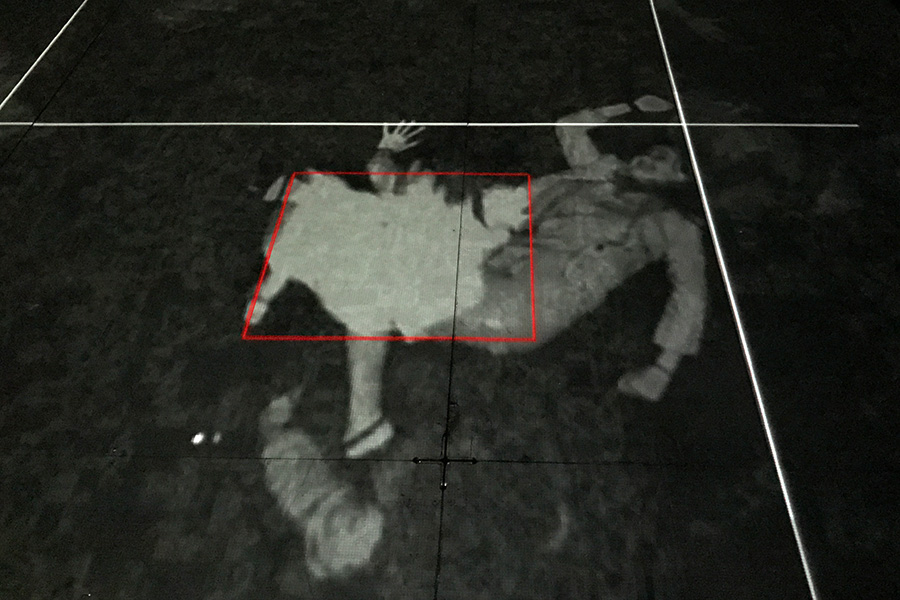
Trump Administration Fantasy League



I don’t play fantasy sports, not because I wouldn’t enjoy it, but more so because I’m not enough of a sports fan. I am however a measured political junky, so when I learned about the Trump Administration Fantasy League, I discovered a fantasy sport that I could find the time and interest to join! Join the Trump Administration Fantasy League by using the site’s random number generator to draft seven unique players from Trump’s administration that includes a selection of 29 players. Then track the league news via Twitter and see your players gain points! The creator of the site Matt McCaleb has been closely monitoring the latest news on the Trump administration to maintain up to date player stats!
Currently former National Security Advisor Mike Flynn is at the top of the score board at 100 points. Devin Nunes is a far second at 65 points. Trump needs to up his game as he’s only fourth at 35 points. If he launches a war against North Korea, I’m certain he’d win hands down (although I don’t see launching a war as a possible stat). The stats used to measure the value of the players include:
- Arrested / Arrests another player 100
- Dies / Kills another player 100
- Resigns / Is fired 75
- Flees jurisdiction 75
- Turns state evidence 75
- Prosecuted for a crime / Prosecutes another player for a crime 75
There are many more stats and some that I question the low value of such as “Fabricates information/Reveals another player’s fabrication of information” as only 10 points. The fabrication of information can of course lead to overwhelming consequences, so I feel it should be worth more. Or perhaps in the new world order, information fabrication is far too normalized to be worth much…
It’s tough to select a team, do you go for the most outspoken that may be out of the game sooner than later such as Bannon or the sleazier ones that may play the long game such as Devin Nunes? And why are Eric and Donald Jr Trump one figure?
With the current 29 players, I would select the following seven:
- Steve Bannon
- Kellyanne Conway
- Devin Nunes
- Jared Kushner
- Rex Tillerson
- Vladimir Putin
- and Donald Trump himself
Woman In Subway
This is the latest animated loop inspired by traversing the city. Whether walking or on public transit, observations of urban life trigger visual ideas that are rendered as brief animations. Audio accompanying the animations are recordings from urban walks as well as interviews with NYC residents. The audio accompanying this animation is from a brief excerpt from an extended interview with my 86 year old neighbor Louise.
Go to rmz.nyc to see the entire series, click on the central image to go from one to the next. Through the combination of animation, WebGL, web video and audio as well as various javascript libraries such as p5.js and three.js, the browser is employed as a canvas.
